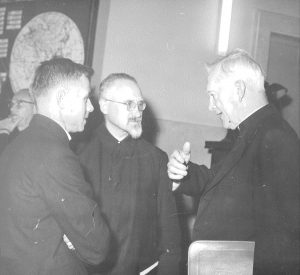
The Archivist’s Nook recently blogged on Monsignor John O’Grady’s early Catholic charity efforts and how he helped make Catholic Charities USA (called the National Conference of Catholic Charity until 1986) a national organization focused on assisting the poor and needy. With the Second World War, O’Grady, by then an experienced and active leader in professional Catholic Charitable work in the United States, turned his attention to assisting those whose lives had been ruined by war.
The immediate postwar years saw millions war refugees gathered in camps throughout Europe. Not only had many individuals found themselves homeless and penniless after hostilities ended, but many had been moved to displaced persons camps, often suffering in crowded, diseased conditions. In the immediate postwar period, the United States worked with other western nations to aid these refugees through organizations such as the International Refugee Organization established in 1946, ultimately assisting 10 million of 15 million stranded in Europe due to the war.¹

Monsignor O’Grady, now at the helm of the National Conference of Catholic Charities (later renamed Catholic Charities USA) for 25 years, made it a personal mission to travel to Europe, tour the refugee camps, and attempt to assist the refugees by coordinating his Catholic charity networks with those of other organizations. He found many obstacles to resettling the refugees. Italian resettlement authorities, for example, were criticized for returning those deemed Nazi collaborators to their original countries of origin, particularly in Eastern Europe, where Soviet authority was solidifying. As he toured dozens of refugee camps in Germany, Italy, and Austria, he noted that “displaced persons now were more than a generic term to me. I had actually seen them in the flesh. I had talked to them. I had found employment for them. I had seen them come off the ships with all their earthly belonging[s] on their backs. I had seen not only individuals but families.” A three-hour tour of refugees from Eastern Europe housed in underground shelters in western Germany shocked him: “One day after a 3-hour tour of one of the underground shelters in Stuttgart, I dropped to the ground and had to be taken out by the people who occupied the shelters. These people had no work; they barely had enough food to keep them alive.”²
In 1947, O’Grady visited with officials at the Vatican on the refugee problem. He thought about the work that needed to be done with the refugees in Christian terms. After meeting the Pope Pius XII on the matter, he noted that “I left the audience with a real faith in the educational mission of our Church throughout the world, in a great international program.”³

When he returned to the United States after his overseas tours of the refugee camps, O’Grady became convinced that many of the remaining displaced should be resettled in the United States. One problem with this aspiration was in the stigma some Americans attached to the refugees. After repatriation of millions, he said, opponents claimed “what we had available were the dregs that had been left.” Moreover, where a Presidential Executive Order of 1945 had paved the way for admission of refugees from Europe to enter the U.S., voluntary groups occupied with the admission process did not have the organizational framework nor the information on the refugees necessary to resettling them in ideal locations. O’Grady believed that religious groups—he particularly admired the Jewish organizational structures with respect to resettlement activities—were better equipped to manage the program because they had pre-existing networks overseas. He worked with a range of religious organizations as well as local governments toward resettling thousands of refugees in the United States, particularly in the Midwest, where a need for farm workers was sorely needed. “We were bringing people in to meet occupational needs in the United States,” he notes of the effort. “This is what we had sold the American people. We had sold them on the idea that we could find jobs and homes for the displaced persons without disturbing American workers. This was a new approach to immigration. It was a sound approach.”⁴
For more on the work of John O’Grady, see the finding aid: http://archives.lib.cua.edu/findingaid/ogrady.cfm
For more on Catholic Charities USA, see the finding aid: http://archives.lib.cua.edu/findingaid/catholicCharities.cfm
An earlier blog on O’Grady and Catholic Charity: https://www.lib.cua.edu/wordpress/newsevents/9315/
¹ See, for example, Mark Wyman, DPs: Europe’s Displaced Persons, 1945-1951 (Ithaca: Cornell University Press, 1989).
² John O’Grady, All That I Have Seen and in Some of Which I Have Had a Part, (unpublished memoir) John O’Grady Papers, Box 21, 268, 265, 279, American Catholic History Research Center and University Archives.
³ O’Grady, All That I Have Seen, 285.
⁴ O’Grady, All That I Have Seen, 279, 288.
